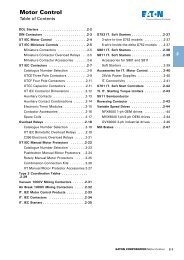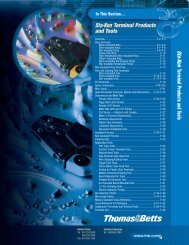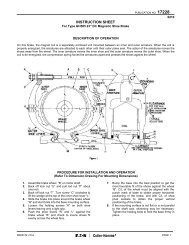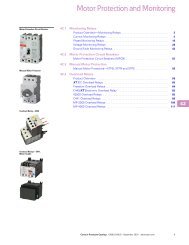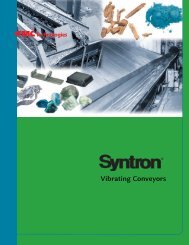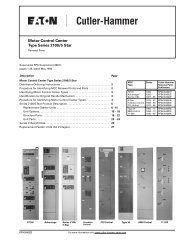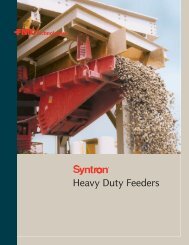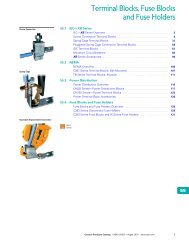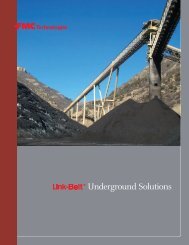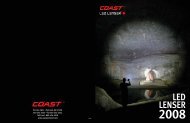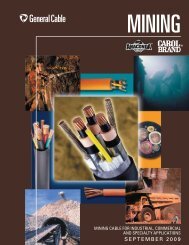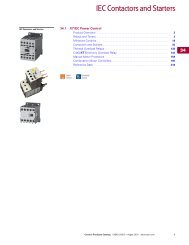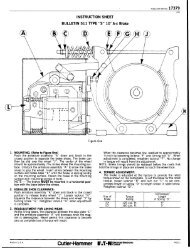NEMA Contactors and Starters - Tri-State Electrical Supply
NEMA Contactors and Starters - Tri-State Electrical Supply
NEMA Contactors and Starters - Tri-State Electrical Supply
Create successful ePaper yourself
Turn your PDF publications into a flip-book with our unique Google optimized e-Paper software.
<strong>NEMA</strong> <strong>Contactors</strong> <strong>and</strong> <strong>Starters</strong><br />
A200 Series<br />
33.2<br />
Relays—Thermal <strong>and</strong> Fast <strong>Tri</strong>p<br />
Relays—Thermal <strong>and</strong> Fast <strong>Tri</strong>p<br />
Product Overview<br />
Type B <strong>and</strong> Type A, Class 20<br />
Thermal Overload Relays<br />
from Eaton’s electrical sector<br />
will protect the motor against<br />
abnormal overload conditions.<br />
Bimetallic actuated, they are<br />
available as either ambient<br />
compensated or noncompensated<br />
in either singlepole<br />
or block type three-pole<br />
design. Type B use one pole<br />
of the three-pole block for<br />
single-phase.<br />
Single-pole relays are also<br />
available as Fast <strong>Tri</strong>p Class 10<br />
ambient compensated type,<br />
which provides approximately<br />
125% motor protection with<br />
a tripping time of less than<br />
10 seconds, at 600% of<br />
heater current rating.<br />
Fast trip relays can be<br />
identified by the green reset<br />
rods. They are available for<br />
panel or starter mounting.<br />
The three-pole fast trip<br />
design is composed of<br />
three single-pole relays<br />
on a common baseplate,<br />
with a common reset bar.<br />
The bimetal element is<br />
actuated by precisely<br />
calibrated heater elements<br />
which are connected directly<br />
in the circuit to be protected.<br />
Thermal actuation of this<br />
device opens the contacts in<br />
the coil circuit of a contactor<br />
or relay which results in the<br />
disconnection of power to<br />
the overloaded circuit.<br />
Interchangeable thermal<br />
heater elements for singlepole<br />
st<strong>and</strong>ard trip <strong>and</strong> block<br />
type overload relays are<br />
available to cover motor full<br />
load currents from 0.29 to<br />
133A in approximately 10%<br />
steps (see Heater Application<br />
Table). Fast trip overload<br />
relays do not have<br />
interchangeable heater<br />
elements but are available<br />
in a series of ratings to cover<br />
motor full load currents from<br />
1.6 to 150A in approximately<br />
50% steps.<br />
Contents<br />
Description<br />
Page<br />
<strong>Contactors</strong>—Non-Reversing <strong>and</strong> Reversing . . . . . . . . . . . . . 64<br />
<strong>Starters</strong>—Non-Reversing <strong>and</strong> Reversing . . . . . . . . . . . . . . . 70<br />
Relays—Thermal <strong>and</strong> Fast <strong>Tri</strong>p<br />
St<strong>and</strong>ards <strong>and</strong> Certifications . . . . . . . . . . . . . . . . . . . . . . 92<br />
Instruction Leaflets . . . . . . . . . . . . . . . . . . . . . . . . . . . . . 92<br />
Thermal Type B, Class 20, Manual Reset. . . . . . . . . . . . . . . 93<br />
Thermal Type A, Class 20, Auto/Manual Reset . . . . . . . . . . 96<br />
Type FT Fast <strong>Tri</strong>p, Class 10 . . . . . . . . . . . . . . . . . . . . . . . . . . 99<br />
Heater Selection . . . . . . . . . . . . . . . . . . . . . . . . . . . . . . . . . . 102<br />
Relays—Current Sensing Protective . . . . . . . . . . . . . . . . . . 104<br />
Features<br />
Manual or Automatic Reset<br />
Type B is furnished with a<br />
manual reset. Type A is<br />
normally furnished set for<br />
manual reset operation <strong>and</strong><br />
may be quickly adjusted<br />
for automatic reset when<br />
required. Automatic reset<br />
should not be used with<br />
two-wire control or where<br />
automatic restarting would<br />
endanger either personnel<br />
or equipment.<br />
<strong>Tri</strong>p Indication<br />
An immediate visible<br />
indication of trip is provided<br />
on the overload relay. When<br />
an overload occurs, which<br />
causes the relay to operate,<br />
a trip indicator projects out<br />
<strong>and</strong> thus shows positive<br />
visual indication of trip.<br />
Type B has a mechanical<br />
trip bar to manually check<br />
the NC contact operation on<br />
the overload relay.<br />
Adjustable <strong>Tri</strong>p<br />
On Type A, the trip rating of a<br />
specific heater element can<br />
be adjusted over a range of<br />
approximately 85% to 115%<br />
of its respective rating to<br />
permit the desired close<br />
protection.<br />
This is accomplished by<br />
turning the adjusting knob<br />
on the relay to the respective<br />
stop position.<br />
Positive Contact Break<br />
A follow-through contact,<br />
provided on the stationary<br />
terminal of the snap action<br />
control switch, provides<br />
reliable electrical continuity<br />
during toggling, thus<br />
eliminating false trip<br />
sometimes prevalent<br />
with thermally operated<br />
switches. This contact also<br />
allows contact wipe for<br />
further reliability.<br />
33<br />
33<br />
33<br />
33<br />
33<br />
33<br />
33<br />
33<br />
33<br />
33<br />
33<br />
33<br />
33<br />
33<br />
33<br />
33<br />
33<br />
33<br />
33<br />
33<br />
33<br />
33<br />
33<br />
33<br />
33<br />
33<br />
33<br />
33<br />
33<br />
33<br />
Control Products Catalog CA08102001E—August 2010 www.eaton.com 91



